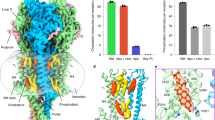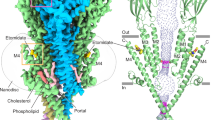Abstract
THE old ‘side-chain’ theory of Ehrlich placed unwarranted emphasis on pictorial symbols designed to represent molecular entities. In an interesting recent article, H. R. Ing1 has suggested that a precise fit between the drug cation and some macro-molecular structure in the living cell is required if a high degree of activity is to be observed". A similar preoccupation with skeletal rather than “dynamic properties of autonomic drugs will be found in the recent speculations of Pfeiffer2, who has suggested that all drugs which possess parasympathetic stimulant action contain a ketone oxygen group adjacent to an ether oxygen linkage with a methyl-substituted nitrogen at a distance of two saturated carbon atoms. The term ”prosthetic’ employed by Pfeiffer for these groups is obviously unacceptable, as pointed out by Ing, who proposes an equally unacceptable term, “pharmacodynamic’ group. Unfortunately, neither of these authors considers the dynamic aspects of cholinergic action. It has been shown3 that cholinergic drugs have outstanding phase-boundary potentials at the interface between saline and lipoid (analogous to the surface of neurones). In a previous communication in Nature4, it was reported that acetyl-choline produces a negative phase-boundary potential which can be calculated from the increase in conductivity of the oil. Additional evidence suggests that no other substance found in nerve is capable of generating sufficient phase-boundary potential to produce the nerve impulse. Unpublished data on adenosine triphosphate demonstrate that this important metabolic agent has feeble electrogenic action, producing only 10 mV. on guaiacol, compared with 35 mV. generated by acetylcholine (both drugs 0·05 per cent). Sodium, potassium, choline, acetate and other constituents of nerve have even lower phase-boundary potentials in artificial systems resembling conditions at the neuronal surface. On a sensitized oil surface, it is possible to measure the electrogenic effect of one part in several million of acetylcholine5. Other nerve substances are inactive at this concentration.
This is a preview of subscription content, access via your institution
Access options
Subscribe to this journal
Receive 51 print issues and online access
$199.00 per year
only $3.90 per issue
Buy this article
- Purchase on Springer Link
- Instant access to full article PDF
Prices may be subject to local taxes which are calculated during checkout
Similar content being viewed by others
References
Ing, H. R., Science, 109, 264 (1949).
Pfeiffer, C. C., Science, 107, 94 (1948).
Barnes, T. C., and Beutner, R., Science, 104, 569 (1946).
Barnes, T. C., and Beutner, R., Nature, 159, 307 (1947).
Beutner, R., and Barnes, T. C., Science, 94, 211 (1941).
Holmes, P. E. B., Jenden, D. J., and Taylor, D. B., Nature, 159, 86 (1947).
Pauling, L., “The Nature of the Chemical Bond’ (1944).
Barnes, T. C., Anat. Rec., 99, 618 (1947).
Barnes, T. C., and Beutner, R., Fed. Proc., 8, 272 (1949).
Clark, A. J., “The Mode of Action of Drugs on Cells’ (1935).
Barnes, T. C., Anat. Sec., 101, 741 (1948).
Barnes, T. C., Anat. Rec., 99, 618 (1947).
Welsh, J. H., Fed. Proc., 8, 162 (1949).
Author information
Authors and Affiliations
Rights and permissions
About this article
Cite this article
BARNES, T., BEUTNER, R. Pharmacodynamic Action of Acetylcholine. Nature 164, 109–110 (1949). https://doi.org/10.1038/164109b0
Issue Date:
DOI: https://doi.org/10.1038/164109b0
Comments
By submitting a comment you agree to abide by our Terms and Community Guidelines. If you find something abusive or that does not comply with our terms or guidelines please flag it as inappropriate.



